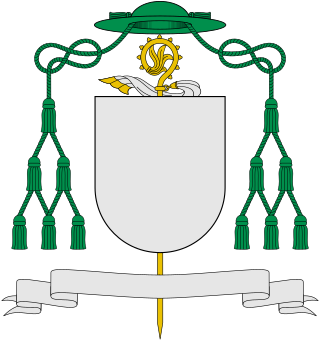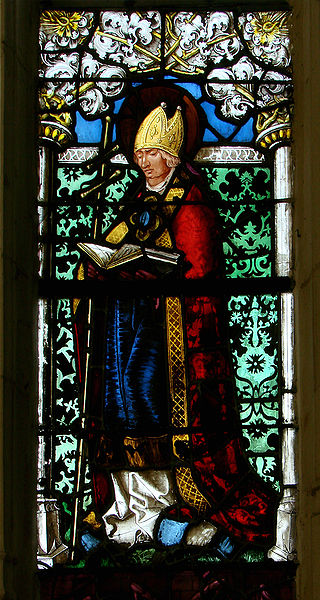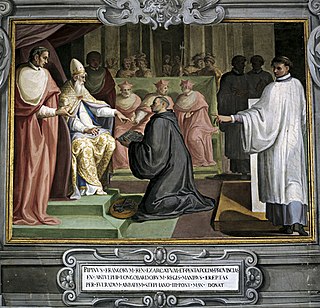Related Research Articles
Primate is a title or rank bestowed on some important archbishops in certain Christian churches. Depending on the particular tradition, it can denote either jurisdictional authority or (usually) ceremonial precedence.
Alan, Abbot of Tewkesbury is said by Gervase of Canterbury to be of English descent. He probably spent some time at Benevento (Italy). Became a monk at Canterbury, rising to prior in 1179. In the struggle between Thomas of Canterbury and Henry II, he was a strong supporter of Thomas. As a result, he went to Tewkesbury as abbot where he was out of Henry's way.
Abbé is the French word for an abbot. It is the title for lower-ranking Catholic clergy in France.

Stephen Harding was an English-born monk and abbot, who was one of the founders of the Cistercian Order. He is honoured as a saint in the Catholic Church.

Ingulf was the Benedictine abbot of Crowland from 1087.

Anglo-Saxon missionaries were instrumental in the spread of Christianity in the Frankish Empire during the 8th century, continuing the work of Hiberno-Scottish missionaries which had been spreading Celtic Christianity across the Frankish Empire as well as in Scotland and Anglo-Saxon England itself during the 6th century. Both Ecgberht of Ripon and Ecgbert of York were instrumental in the Anglo-Saxon mission. The first organized the early missionary efforts of Wihtberht, Willibrord, and others; while many of the later missioners made their early studies at York.
Dúnchad mac Cinn Fáelad was the eleventh abbot of Iona (707–717). He was the son of Cenn Fáelad, and grandson of Máel Coba, of the Cenél Conaill. While most early abbots of Iona were members of Cenél Conaill they came from minor branches of the kindred, but Dúnchad came from the ruling line, grandson of one High King of Ireland and the nephew of two others, Cellach and Conall.

A territorial abbey is a particular church of the Catholic Church comprising defined territory which is not part of a diocese but surrounds an abbey or monastery whose abbot or superior functions as ordinary for all Catholics and parishes in the territory. Such an abbot is called a territorial abbot or abbot nullius diœceseos. A territorial abbot thus differs from an ordinary abbot, who exercises authority only within the monastery's walls or to monks or canons who have taken their vows there. A territorial abbot is equivalent to a diocesan bishop in Catholic canon law.
Rodulfus, was an 11th-century Benedictine chronicler.
A homiliarium or homiliary is a collection of homilies, or familiar explanations of the Gospels.
Kingisel is the name of two non-consecutive Roman Catholic abbots who ruled Glastonbury Abbey in the seventh and eighth centuries respectively.
Osbern of Canterbury or Monk Osbern was a Benedictine monk, hagiographer and musician, precentor of Christ Church, Canterbury.
David Scotus was a Gaelic chronicler who died in 1139.
Hugh of Fleury was a French Benedictine monk and ecclesiastical writer. He is known only by his works.
Jacques Bouillart was a Benedictine monk of the Congregation of St.-Maur.

Godfrey Henschen, 21 June 1601 – 11 September 1681, was a Jesuit hagiographer, one of the first Bollandists, from the Spanish Netherlands.
Lambert of Saint-Bertin was a French Benedictine chronicler and abbot.

Saint Claudius of Besançon, sometimes called Claude the Thaumaturge, was a priest, monk, abbot, and bishop. A native of Franche-Comté, Claudius became a priest at Besançon and later a monk. Georges Goyau in the Catholic Encyclopedia wrote that “The Life of St. Claudius, Abbot of Condat, has been the subject of much controversy.” Anglican Henry Wace has written that "on this saint the inventors of legends have compiled a vast farrago of improbabilities."
Marianus Scotus of Regensburg, born Muiredach mac Robartaig, was an Irish abbot and scribe.

From 756 to 857, the papacy shifted from the influence of the Byzantine Empire to that of the kings of the Franks. Pepin the Short, Charlemagne, and Louis the Pious had considerable influence in the selection and administration of popes. The "Donation of Pepin" (756) ratified a new period of papal rule in central Italy, which became known as the Papal States.
References
 This article incorporates text from a publication now in the public domain : Herbermann, Charles, ed. (1913). "The Monk of Malmesbury". Catholic Encyclopedia . New York: Robert Appleton Company.
This article incorporates text from a publication now in the public domain : Herbermann, Charles, ed. (1913). "The Monk of Malmesbury". Catholic Encyclopedia . New York: Robert Appleton Company.